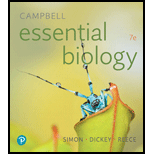
Concept explainers
Suppose you wish to create a large batch of the protein lactase using recombinant DNA. Place the following steps in the order you would have to perform them.
- a. Find the done with the gene for lactase.
- b. Insert the plasmids into bacteria and grow the bacteria into clones.
- c. Isolate the gene for lactase.
- d. Create recombinant plasmids, including one that carries the gene for lactase.
To determine:
The sequence of steps that will performed by the individual if he wants to create a large batch of protein lactase using recombinant DNA.
Introduction:
Recombinant DNA technology involves excising the DNA of interest from one genome and inserting into a foreign genome by identification, isolation, manipulation and re-expression of genes.
Answer to Problem 1SQ
Correct answer:
The order of the steps for producing large batch of the protein lactase using recombinant DNA are c.,d.,b. and a.;
c. isolate the gene for lactase,
d. create recombinant plasmid, including one that carries the gene for lactase.
b. insert the plasmids into bacteria and grow the bacteria into clones,
a. find the clone with the gene of lactose.
Explanation of Solution
Recombinant DNA technology is a process that includes transfer of a desired DNA sequence or genes from one organism to a self-replicating genetic element such as bacterial plasmid followed by propagation in host cell. The steps involves in the formation of recombinant are as follows;
- The gene of interest is identified and isolated and inserted into plasmid (vector). The joining of DNA from two different sources results in the formation of recombinant DNA plasmid.
- The recombinant plasmid is inserted into the bacteria for multiplication. Under the right condition, the bacteria take up the recombinant plasmid.
- Each bacterium carrying the recombinant plasmid is allowed to reproduce through the cell division to form the clones of cells.
- The identified transgenic bacteria with the gene of interest can be grown in tanks to produce a large amount of desired protein.
Want to see more full solutions like this?
Chapter 12 Solutions
Campbell Essential Biology (7th Edition)
- In relation to the use of restriction enzymes in recombinant DNA technology, answer the following: You have accidentally torn the labels off two tubes (tube A and tube B), each containing a different plasmid, now you do not know which plasmid is in which tube. Fortunately, you have restriction maps for both plasmids, shown in Figure below. You have the opportunity to test just one sample from one of your tubes. By utilizing agarose gel electrophoresis technique, which restriction enzyme OR combination of restriction enzymes would you use in this experiment to determine which plasmid is found in which tube?. (Hint: if you use Hind III restriction enzyme you are going to get ONE single fragment with a molecular size of → 0.5+0.3+0.2+0.4+1+1 = 3.4 kb).arrow_forwardYou want to propagate large amounts of a DNA fragment. To do this, use a plasmid vector. a) How should this plasmid vector be constructed? b) Also describe the function of the components.arrow_forwardCloning Genes Is a Multistep Process In cloning human DNA, why is it necessary to insert the DNA into a vector such as a bacterial plasmid?arrow_forward
- Describe the possible outcome of a PCR experiment in which (a) there is a single-stranded break in the target DNA sequence, which is present in only one copy in the starting sample, and (b) there is a doublestranded break in the target DNA sequence, which is present in only one copy in the starting sample.arrow_forwarda. Using nucleotide letters, show the kind of cut that could be made on a DNA molecule to circularize it into a plasmid. b. What are restriction length polymorphisms, and how are they used?arrow_forwardUsing a flow diagram, elaborate on how you would generate a recombinant plasmid.arrow_forward
- From where do we get primers for sequencing DNA? A) they are synthesized by reverse transcriptase B) they are cut out of plasmids using restriction endonucleases C) DNA primase is added to the sequencing reaction and synthesizes the primers D) biotechnology companies synthesize them using organic chemistryarrow_forwardIn pcr experiment, Does electrophoresis show that only DNA products of the desired size are present? If not, what do you think is the reason?arrow_forwardIn isolating DNA in strawberries, can you isolate other biomolecules aside from DNA just by using commonly available household materials and chemicals? Elaborate on your answer.arrow_forward
- When making recombinant DNA, why must you use the same restriction enzyme to cut the gene of interest and the plasmid?arrow_forwardIn cloning human DNA, why is it necessary to insert the DNA into a vector such as a bacterial plasmid?arrow_forwardDescribe how restriction enzymes like EcoR1 are used to create recombinant plasmids and what the process is for using these plasmids to replicate a piece of target DNA. Include information about how to create sticky ends, the makeup of the bacterial plasmid and how to tell if the gene was successfully inserted in the plasmid and if the plasmid has been transformed by the bacteria. You may use a drawing to enhance your description.arrow_forward
 Human Heredity: Principles and Issues (MindTap Co...BiologyISBN:9781305251052Author:Michael CummingsPublisher:Cengage Learning
Human Heredity: Principles and Issues (MindTap Co...BiologyISBN:9781305251052Author:Michael CummingsPublisher:Cengage Learning
